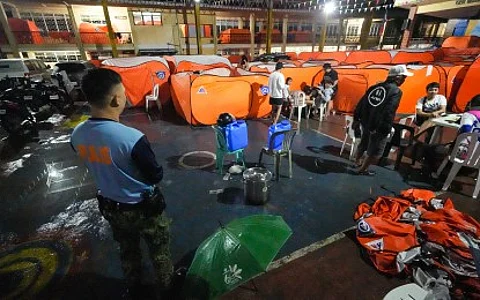
- NEWS
- the EDIT
- COMMENTARY
- BUSINESS
- LIFE
- SHOW
- ACTION
- GLOBAL GOALS
- SNAPS
- DYARYO TIRADA
- MORE

As floodwaters continue to rise across Metro Manila and nearby provinces, the Armed Forces of the Philippines (AFP) is working with international partners — including the United States Indo-Pacific Command (USINDOPACOM) — to maximize the use of Enhanced Defense Cooperation Agreement (EDCA) facilities for disaster response operations, Defense Secretary Gilberto Teodoro Jr. said Tuesday.
Speaking from Washington, D.C., where he is accompanying President Ferdinand Marcos Jr. on a three-day official visit, Teodoro stressed the importance of international defense cooperation in supporting local efforts to respond to the damage caused by tropical depression “Crising” and the intensified southwest monsoon rains.
“This is where our fellow Filipinos will see the value of military cooperation — helping our people survive nature’s toughest challenges,” said Teodoro, who also chairs the National Disaster Risk Reduction and Management Council (NDRRMC).
The USINDOPACOM is sending a crisis action team to the Philippines to support ongoing relief efforts amid the devastating impact of recent typhoons, added Teodoro.
He noted that the Philippine government is also coordinating with other key allies, including Japan, to ensure rapid aid delivery and boost emergency response capabilities.
Despite being overseas, Teodoro assured Filipinos President Marcos remained fully engaged in monitoring the situation back home.
“Rest assured, the President is closely monitoring the situation 24/7 from here in the US,” he said. “Before we even left Manila, the President had already given clear instructions to government agencies to prepare for the flooding.”
Marcos is in Washington for meetings with US President Donald Trump and other American officials, but Teodoro emphasized that the Chief Executive has directed all necessary resources to be mobilized for flood-affected communities.
Tropical depression “Crising,” made worse by southwest monsoon rains, has caused days of heavy flooding, forcing the suspension of classes and government work since Monday.
Teodoro said the government’s disaster response systems are fully operational, with the Inter-Agency Coordinating Cell functioning as the central hub for rescue, relief, and logistics operations.
“We’re not just responding to the immediate needs of those affected — we’re also anticipating the next steps that need to be taken,” he added.
All EDCA sites activated
In a press briefing at Camp Aguinaldo, AFP spokesperson Col. Francel Margareth Padilla confirmed that all nine EDCA sites across the country have been activated to support ongoing disaster response efforts.
“These sites are now serving as hubs for prepositioning military assets and command centers for search, rescue, and relief missions,” Padilla said. “This isn’t the first time we’ve used EDCA facilities during disasters — they’re multirole facilities.”
Padilla explained that whichever EDCA site is closest to the most affected areas will be used accordingly — for command and control, repacking relief goods, or other emergency operations.
The nine EDCA sites include Cesar Basa Air Base in Pampanga, Fort Magsaysay in Nueva Ecija, Lumbia Airport in Cagayan de Oro, Antonio Bautista Air Base in Palawan, Benito Ebuen Air Base in Cebu, Naval Base Camilo Osias in Cagayan, Lal-lo Airport also in Cagayan, Camp Melchor Dela Cruz in Isabela, and Balabac Island in Palawan.
Teodoro previously noted that these sites were strategically developed in disaster-prone areas — not just for defense and deterrence, but also for humanitarian and disaster response missions.
Allies in action
AFP Chief of Staff Gen. Romeo Brawner Jr. highlighted the vital role of international partnerships in ongoing operations, saying the activation of EDCA sites shows how defense ties — especially with the US — are helping get aid where it’s needed.
